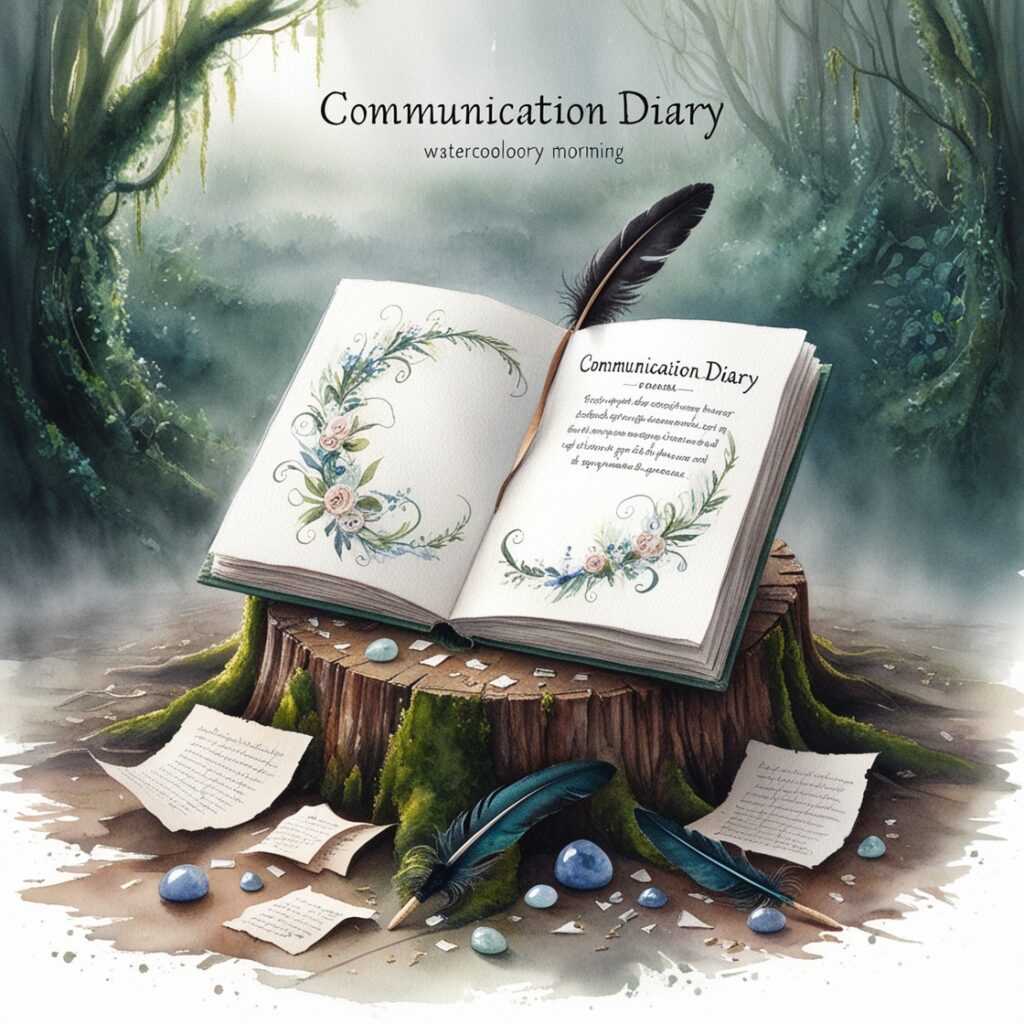Verbs of Communication

Learning goals
-You will be able to define verbs of communication and identify their roles in conveying messages and information.
– You will be able to recognize and accurately use common verbs of communication such as say, tell, speak, talk, ask, answer, reply, discuss, explain, shout, whisper, announce, declare, and mention in various contexts.
-You will improve your active listening and speaking skills through role-playing and debates, ensuring you can use verbs of communication effectively in conversations.
-You will be able to write clear and coherent texts using a variety of verbs of communication, demonstrating an understanding of their proper usage.
-You will become more aware of how you use verbs of communication in daily interactions and will be able to analyze and reflect on your communication habits.
General Information
Verbs of communication are words that describe actions related to the expression of ideas, thoughts, feelings, and information. These verbs are essential for engaging in conversations, discussions, debates, storytelling, and more. They help to express how we convey information and to whom, whether it’s done formally, casually, loudly, quietly, or with emotion.
Keep in mind that effective communication requires not only speaking but also choosing the right verb depending on the context. For instance:
- Formality: Some verbs are more formal than others, and knowing when to use them is key in professional or academic settings.
- Clarity: Using precise verbs helps make your point clearer, especially when explaining something complicated or giving instructions.
- Tone: Verbs like “whisper,” “shout,” or “argue” can change the tone of the message, whether it’s quiet, loud, or confrontational.
Examples

- Say: Used to express words spoken by someone.
- Example: She said she would come to the party.
- Tell: Used when informing someone about something.
- Example: He told me the secret.
- Speak: Used to describe the act of talking, often focusing on the ability or process.
- Example: She speaks three languages fluently.
- Talk: Similar to “speak” but often used for more casual conversation.
- Example: Let’s talk about your plans for the weekend.
- Ask: Used when posing a question.
- Example: I asked him if he could help me.
- Answer: Used to respond to a question.
- Example: She answered all the questions correctly.
- Reply: Used to respond, often in a conversation or correspondence.
- Example: He replied to her email promptly.
- Discuss: Used when talking about something in detail.
- Example: We need to discuss our project proposal.
- Explain: Used to make something clear or understandable.
- Example: Can you explain this math problem to me?
- Announce: Used to make a public or formal statement.
- Example: They announced the winners of the competition.
Types of Verbs of Communication
Verbs of communication can be grouped into different categories based on how they are used or the purpose of the communication. Let’s look at several categories:
Verbs of Speaking
These verbs describe actions related to speaking aloud, either directly or indirectly.
- Say: To express words or information.
Example: She said that she was going to the party. - Speak: To use one’s voice to express words, usually in a formal setting or with a broader audience.
Example: He spoke at the conference about climate change. - Talk: To engage in conversation. It’s a more informal verb than “speak.”
Example: They were talking about their weekend plans. - Announce: To make a formal statement to the public.
Example: The teacher announced the results of the competition. - Whisper: To speak very softly, usually to keep the message private.
Example: She whispered the secret to him.
Verbs of Telling and Sharing Information
These verbs describe actions where one person provides specific information to another.
- Tell: To give information or instructions to someone.
Example: I told him to meet me at the café. - Inform: To provide someone with knowledge or information.
Example: I’ll inform you of the changes in the schedule. - Advise: To offer suggestions or recommendations.
Example: My doctor advised me to exercise regularly. - Describe: To explain something in detail using words.
Example: She described her trip to Paris in great detail.
Verbs of Questioning
These verbs involve asking for information or clarification.
- Ask: To request information or an answer.
Example: Can I ask you a question? - Inquire: A more formal way of asking.
Example: He inquired about the job opening. - Question: To ask for information in an analytical or probing way.
Example: The journalist questioned the politician about his stance on the issue.
Verbs of Explaining and Clarifying
These verbs help to provide more understanding or context about something.
- Explain: To make something clear or easy to understand.
Example: Can you explain the rules of the game? - Clarify: To make something easier to understand or to remove confusion.
Example: She clarified the instructions for the new project. - Interpret: To explain the meaning of something, often in a more interpretive or subjective way.
Example: He interpreted the poem as a reflection on love and loss.
Verbs of Expressing Opinions and Emotions
These verbs involve sharing feelings, attitudes, or viewpoints.
- Express: To convey thoughts, emotions, or opinions.
Example: He expressed his gratitude for all the help. - Suggest: To propose an idea or recommendation.
Example: I suggest we meet tomorrow for lunch. - Argue: To present reasons for or against something in a debate-like manner.
Example: They argued about the best course of action. - Complain: To express dissatisfaction or frustration.
Example: She complained about the noisy neighbors. - Praise: To express approval or admiration.
Example: The teacher praised the students for their hard work.
Verbs of Conveying and Reporting Information
These verbs describe actions of delivering or transmitting information.
- Report: To deliver news, details, or findings, often in a formal manner.
Example: The news anchor reported the latest developments. - Relay: To pass on information or a message.
Example: I will relay your message to her. - Convey: To transmit or make something known.
Example: His words conveyed a sense of urgency. - Broadcast: To share information widely, often through media channels.
Example: The company broadcasted their new product launch live.
Verbs of Repeating or Restating Information
These verbs describe actions where information is being repeated or summarized.
- Repeat: To say or do something again.
Example: Can you repeat what you just said? - Reiterate: To say something again, often for emphasis or clarification.
Example: I want to reiterate the importance of safety in the workplace.
If you want to learn more about verbs, you can visit this link: Verbs: The Definitive Guide
Learning Activities
EGB
“Communicating Choices” (Verbs of Communication + Either/Neither)
Objective:
This activity helps you practice using either, neither, and verbs of communication to express choices and preferences.
How It Works:
- You will work in pairs. One person will ask questions, and the other will answer using either or neither.
- Your task is to use either or neither with the correct verb of communication (such as say, ask, tell, suggest, etc.) to show your choice or lack of choice.
Examples:
- If your partner asks, “Do you prefer pizza or pasta?” you can answer:
- “I either like pizza or pasta, but I’m not sure which one today.”
Or, - “I neither like pizza nor pasta, I prefer salad!”
- “I either like pizza or pasta, but I’m not sure which one today.”
- For questions like, “Do you want to go to the movies or stay at home?” you could say:
- “I neither want to go to the movies nor stay at home. I want to go out with friends.”

“The Communication Chain” (Chain Activity with Verbs of Communication)
Objective:
You will practice using both and verbs of communication to express agreement or disagreement with more than one item.
How It Works:
- Sit in a circle with your classmates. The teacher will start by saying a statement using both and a verb of communication, for example:
- “I both heard and read that video games are fun.”
- The next person in the circle has to agree or disagree using both and a different verb of communication. For example:
- “I both agree and feel that video games are exciting.”
- Continue around the circle, each person using both and a new verb of communication to express their thoughts on the topic.
Example:
- The teacher says: “I both believe and understand that reading books is important.”
- Student 1: “I both know and agree that reading helps improve language skills.”
- Student 2: “I both think and suggest that we should read at least one book per month.”

“Create the Dialogue” (Using Either/Neither + Verbs of Communication)
Objective:
You will create a conversation using either, neither, and appropriate verbs of communication to respond to different situations.
How It Works:
- You will work in pairs or small groups to create a short dialogue (4-6 lines) based on the following prompts. In your dialogue, you must use either, neither, and at least two different verbs of communication.
Prompts for the Dialogue:- Talking about choosing between two things (e.g., activities, food, movies).
- Discuss whether you agree or disagree with a statement or opinion.
- Deciding between two invitations or offers.
- After creating the dialogue, you will perform it in front of the class or for another pair.
Examples:
Prompt 1: Choosing between activities
- Student 1: “Do you want to play soccer or basketball after school?”
- Student 2: “I neither want to play soccer nor basketball. I’d rather go swimming.”
Prompt 2: Agreeing or disagreeing with an opinion
- Student 1: “I think traveling by train is better than flying.”
- Student 2: “I both agree and suggest we try taking the train to the next city.”

BGU
Role-Playing Conversations
Objective: Practice using verbs of communication in real-life scenarios.
Instructions:
- This activity will be done in pairs.
- Each pair will be provided with a scenario card that includes a situation requiring communication (e.g., a job interview, a parent-teacher meeting, a debate about a school policy, etc.)
- Each pair acts out the scenario using as many verbs of communication as possible.
- After each role-play, the class will be asked to identify the verbs of communication used.

Communication Diary
Objective: Enhance your awareness of how you use verbs of communication in daily life.
Instructions:
- Keep a diary for one week, recording at least five instances each day where you used verbs of communication.
- Each entry should include the context, the verb used, and the purpose of the communication.
- At the end of the week, share some of your entries with the class and discuss any patterns or insights you observed.

Communication Debate
Objective: Encourage yourself to use verbs of communication in structured arguments.
Instructions:
- The class will be divided into two groups and will be assigned a position on a debate topic (e.g., “Social media improves communication” vs. “Social media hinders communication”).
- Each group prepares their arguments, ensuring you use a variety of verbs of communication.
- Each side will be presenting their arguments and responding to the other side’s points.
- After the debate, we will discuss how effectively each group used verbs of communication to make their points.

